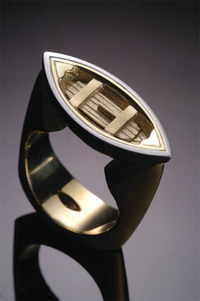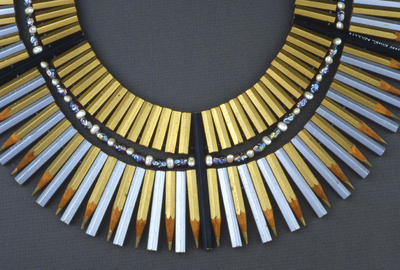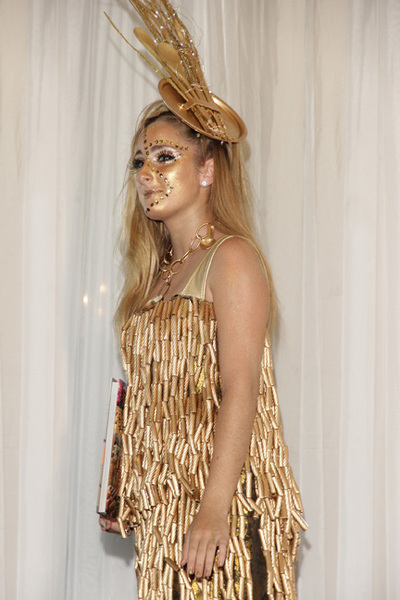WEARABLE ART OUTSIDE THE URBAN CENTER PART 1
FASHION SPEAKS A VISUAL LANGUAGE through patterns, textures, color and shape, with which we are all accustomed. When wearable materials demonstrate unusual artistry or eccentricity, they illustrate the process of craft and possibilities of fashion, lending new meaning to the mid-20th-century concept of Wearable Art.

Swan&Stone Millinery, Sunburst Wooden Cocktail Hat, 2012, hand-turned local wood, natural pheasant feathers, felt, 7 x 7 x 3″. Photo: Najat Croll.
In New England, outside of the urban centers of fashion, artists and businesspeople are engaged in making and showing Wearable Art that draws upon local needs, materials, and aesthetics while sometimes importing far-flung inspirations and designers and setting them under one roof. Many regional locations are marked by attention to art that fits within a community, yet may also help define it. This first look at eccentric and Wearable Art in New England highlights some of the local infrastructure and sketches the contours of the means by which Wearable Art finds its place within art, craft, and the shape of various communities.
One prominent local organization, on Cape Ann, Massachusetts, is the Society for the Encouragement of the Arts, or seARTS, founded to promote local artistic ventures and bring new patrons and artists to the area. The Wearable Art group, an area of shared interest within seARTS, has long presented a holiday show of work, and produced its second Celebrate Wearable Art runway show in September 2013. Runway designs included the ebullient A-line plaid and glowing pink skirt anchored with geometric stripes of Jen Greeke’s Harpy line, and Arrowhead Designs’ lengthy coat dress extended upwards by the military precision of the shoulders. Before the runway show, artists exhibited work within the venue. Among them, Claudia Brahms sold astonishing shoulder bags made of recycled paper and displayed a soft abundance of earth-toned striped scarves; Couture Planet (“making fashion headlines”) had enticing earth-friendly accessories made with recycled newspapers; Lisa Pedemonti-DiPietro was surrounded by her luxurious, playful hats.

Thomas O’Donovan, Journey Boat Series, Dory signet ring in 18k/Platinum with .22ct marquis diamond set in palm side of ring. Courtesy of the artist and Harbor Square Gallery.
The desire to combine resources and talents through beneficial collaborative events has evolved over the years at seARTS, as elsewhere. After jewelry salons grew to holiday sales, the group’s addition of a runway show was inspired by the World of Wearable Art show in New Zealand and work at the Boston experimental art organization, Mobius. The number of participating local artists greatly expanded after the success of an inaugural 2011 Celebrate Wearable Art event, and artists now also decorate and host luncheon tables alongside the runway. The accessibility of selling work, networking, and collaborating “has allowed the artists to participate in a different way; they’re part of the event,” says Jacqueline Ganim-DeFalco, sea-glass jewelry artist and chair of the seARTS’ board of directors. For seARTS, the show of Wearable Art is one way of publicizing the work of its arts community and members, while simultaneously activating new avenues and connections within this group. The social and visual variety provided by a fashion show fosters growth on the individual and local scale. Attention to makers “will bring out a lot of different creative talents—you’re not limiting the kind of artist or even community member who participates,” says Ganim-DeFalco. In exhibition and display, the work appeals to audiences far beyond the North Shore.

Jacqueline Ganim-DeFalco, Cape Ann Designs, Sea Glass Wearable Art, sea glass hair barrette framed by Coca-Cola Glass and brown sea pottery. Photo: © Linehan Photography.
In western Massachusetts, Paradise City Arts Festivals provide ongoing venues for artists to sell their work through fairs in Northampton and Marlborough. The spring Marlborough show takes place March 22–24, and the spring Northampton show May 24–26. Jewelry and fashion make up one of three categories in which artists can submit work to these juried exhibitions. Founders Geoffrey and Linda Post bring together artists from across the United States and Canada, and their approach to publicity and display prioritizes accessibility. Artists’ work is displayed in an online database of skilled craftspeople. Mary Lynn O’Shea is one expert designer in the group, combining unexpected colors and panels in her line of tailored, smoothly textured jackets, coats and vests. O’Shea taught art and weaving at the college level before intensifying her own work in textiles at her Vermont studio. Sam Stone and Nora Swan, together working as Swan&Stone Millinery, produce finely balanced products, from felted hats in subdued or sunny colors, to elaborate fascinators and smoothly shaped straw hats. Their commitment to using materials primarily raised and gathered from their Vermont farm is related to the desire of many New England artists to be attentive to products that are locally available. Patricia Palson, another artist who exhibits her work with Paradise City in Marlborough, shows handwoven, brilliantly colored jackets and coats from her New Hampshire workshop.

Patricia Palson, Tiered Dress, 2013, handwoven merino wool and tulle, 16 x 48″. Model: Tamara Chapman. Photo: Bruce Preston.
The ability of artists to exhibit or sell their work without going into large cities or shipping pieces long distances is also promoted by the League of New Hampshire Craftsmen. The League has existed since 1932 and maintains a commitment to artists from that state or its close borders. Its Hanover League writes that “the inspiration and education of artists and the broader community” is part of its mission. Juried artists, Palson among them, exhibit each August at Sunapee Resort in Newbury, New Hampshire, yet also have work on view at various locations throughout the area and sometimes provide classes and workshops. Kathleen Curtin’s burnished metalwork, in unique totemic and natural forms, and Stephanie Robinson’s jewelry, featuring complex wire contour tracings of geometric shapes, have been exhibited at multiple locations. Wearable Art is shown at these galleries alongside other locally handcrafted pieces such as ceramic vessels or furniture.

Kerstin Nichols, Egyptian Collar (detail), 1985, pencils, glass beads and pearls, approx. 14 x 5″. Photo: Kerstin Nichols.
Harbor Square Gallery in Rockland, Maine, also showcases a variety of media by Maine artists. Owner Thomas O’Donovan and Glade Sarbach Davis work with many artists drawing inspiration from natural forms and mythological or spiritual underpinnings of figurative and outdoor imagery. The gallery’s jewelers, along with O’Donovan, explore a spectrum of materials, and these products exude warmth and tactile familiarity despite their precious materials. O’Donovan’s “earscrew” earrings evoke graceful movement around a centripetal force, yet are designed around a carefully tuned awareness of the closeness of the wearer’s body. Both intimate and futuristic, the screws are related in their delicacy to the work of Antje Roitzsche. Her pieces evoke both collision and expansion of familiar objects like leaves. Boldness in the telescoping shapes is balanced by the intricacy of the carved surfaces. Nancy Linkin’s abstract jewelry also blends airy arcs with gradations into thicker areas of emphasis, in several metals, while the textures of Michael Banzhaf’s gold and platinum jewelry constitute a surface that slows the progress of the eye across even a small area.

Designer: Felicia Mohans, model: Amanda Mohans, makeup: John Sheehan, seARTS’ Celebrate Wearable Art II runway show, Gold pasta dress, 2013, 10 lbs. of gold pasta, created to promote the newly-released cookbook, Gifts of Gold, written by local author Sista Felicia. Photo: © Linehan Photography.
Throughout New England, other makers of eccentric and unique art curate or bring together a wider circle of artists, both local and international, highlighting diverse or shared aesthetics and inspirations. Great Barrington, Massachusetts, is home to the Karen Allen Fiber Arts shop which displays a range of work from around the world as well as the artist and actor’s own cashmere textiles. Allen writes that “the people that come to my shop in Great Barrington are coming to look at the sort of gifts and clothing that are not commonly found in one store.” Allen herself hand designs and knits vibrant and distinctively patterned scarves, hats, and sweaters, informed by her own interest as a “student of the history of textiles from all over the world” and academic study of varied processes of making. In the shop, intricate woven dances of colors adorn clothing by Bass River artist Randall Darwall, alongside the brilliant stones of Saskia Larraz’s glass jewelry. In a different aesthetic vein, Sigrid Olsen’s Massachusetts gallery and store, ISLA beach house, compiles works from international artists that expand upon a cheerfully colored beach theme. Red Pepper Gallery of Chester, Connecticut, brings together pieces ranging from the loosely woven California designs of Robin Taylor to the kinetic, provocative reused rubber jewelry of Alabama artist Kathleen Nowak Tucci.
In Lenox, Massachusetts, Sienna Gallery presents novel interpretations of jewelry and publishes related material in books and catalogues. Among gallery artists, Arthur Hash uses contemporary technology to make his jewelry, though these pieces are drawn from natural forms and often evoke traditional techniques. Tracy Steepy utilizes familiar patterns and shapes in novel conjunctions to create dialogue between the two- and three-dimensional, or, as the Rhode Island artist writes, “landscapes hidden in between and exposed.”
Attention to unique combinations, dedication to craft, and inspiration stemming from the local environment are all characteristic of New England Wearable Art
makers. How their work has been enfolded into the growth, character, and
natural landscapes of communities provides another layer of meaning to the works that are produced, seen, and sold outside of the region’s major cities. Growth of these organizations may seem organic, yet proprietors,
organizers, and curators have in common a creative passion and conviction in the place of art within the life of each community that drives their own practices to adapt and intermingle.
Wearable Art Outside the Urban Center Part Two appears in Art New England’s upcoming May/June 2014 issue.
Rachel Shipps is an educator and writer in the arts and humanities, completing an MA at Brown University.
FOR REFERENCE:
Artisans Hand Craft Gallery
Montpelier, VT
artisanshand.com
Karen Allen
Fiber Arts, Great Barrington, MA
karenallen-fiberarts.com
Couture Planet
Lynn, MA
mycoutureplanet.com
Edgewater Gallery
Middlebury, VT
edgewatergallery-vt.com
Harbor Square Gallery
Rockland, ME
harborsquaregallery.com
ISLA Beach House
Gloucester, MA
sigridolsenart.com/collections/
isla-beach-house/ISLA
League of New Hampshire Craftsmen
Concord, NH
nhcrafts.org
Paradise City Arts Festival
Northampton and Marlborough, MA
paradisecityarts.com/index.html
Red Pepper Gallery
Chester, CT
redpepperessexct.com
seARTS
Cape Ann, MA
searts.org
Sienna Gallery
Lenox, MA
siennagallery.com
